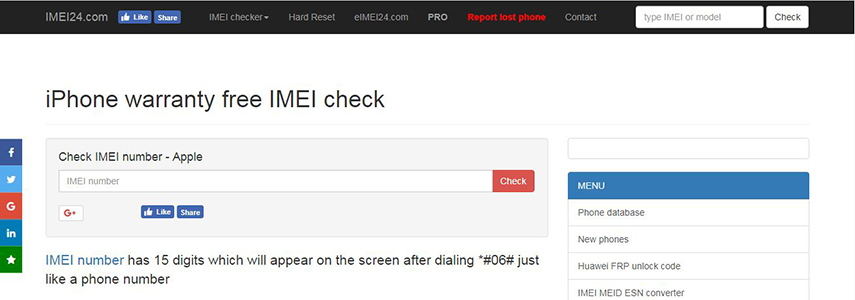Unique identifier can be understood as a global unique identifier (GUID), which can be initialized using the newid function to convert string constants into the following form ( xxxxxxxx-xxxx-xxxx-xxxx-xxxxxxxxxxxx), where each x is a hexadecimal number in the range of 0-9 or a-f). Convert a Decimal MEID to Hex. If an invalid Decimal MEID is used, it will throw a warning and return 0. Convert a Hex MEID to Decimal. If an invalid Hex MEID is used, it will throw a warning and return 0. Check to see if a MEID is valid, either Decimal or Hex. If it looks like a Decimal MEID, it returns. Free IMEI number converter. If you want to know what is your MEID number in decimal (DEC) or hexadecimal (HEX)? After entering the IMEI number the system will generate MEID HEX, MEID DEC, P (ESN) HEX, P (ESN) DEC numbers. You will also receive information about your phone's model and brand. Test your JavaScript, CSS, HTML or CoffeeScript online with JSFiddle code editor. Take the 6 hex characters and convert them to dec. If this dec number is less than 8 digits, add enough leading zeroes so the dec is displayed with exactly 8 digits always! (for example: a hex ESN ending with the 6 characters of 109AFF, would be equal to 1088255 in dec.
Enter your Identifier Number (IMEI) and it will convert to every format of device unique codes such as MEID and ESN.
This calculator uses also pseudo ESNs (pESN), ESNs, and MEID numbers in both decimal and hexadecimal forms. You may use this tool in order to convert between IMEI, MEID and ESN, and to view both decimal and hexadecimal formats. This calculator may be very helpful especially when you are trying to activate your device with a carrier that requires unique identifier in a strictly specified format
What are IMEI, ESN and MEID identifiers?
IMEIs, ESNs and MEIDs are numbers and codes used by the mobile producers in order to ensure the unique identificator for each devices. Generally speaking each device have assigned one IMEIs, ESN or MEID.

What is the MEID Number?
The MEID Number (Mobile Equipment Identifier) is a unique 56-bit identification code for CDMA mobile devices. The MEID number is permanently stored in the device. The MEID is a replacement for ESN (electronic serial number) since 2006. The MEID Number consists of the following parts:
- 8-bit regional code (RR)
- 24-bit manufacturer code
- 24-bit number assigned by the manufacturer
- (CD) is not considered part of MEID
We can distinguish two standard formats for MEIDs identifier, and both may contain an optional check-digit:
- Hexadecimal Form – this standard is expressed in 14 digits grouped together and applies whether all digits are in the decimal range or whether some are from the range A - F. When the all elements are from '0'-'9' range than the check-digit is converted by using the normal base 10 Luhn algorithm. In the second case when at least one digit is A - F range the check-digit algorithm uses base 16 arithmetic.
- Decimal Form – this standard is converted by changing the manufacturer 32-bits code to decimal and padding on the left with '0' digits to 10 digits and separately converting the serial number to decimal and afterwards padding on the left to 8 digits. A check-digit can be converted from the 18 digit result using the base 10 Luhn algorithm and appended to the end. The decimal form is specified by 18 digits grouped in a 5 5 4 4 pattern .
Convert To Media Player
What is the IMEI Number?
The IMEI (International Mobile Equipment Identity) is a unique number to identify GSM, WCDMA, and iDEN mobile phones, as well as some satellite phones. The IMEI is only used for identifying the device and has no permanent or semi-permanent relation to the subscriber. Number is used by the GSM network to identify valid devices and therefore can be used for stopping a stolen phone from accessing the network in that country.
What is ESN?
ESN - Electronic Serial Numberis a unique 32-bits identification number embedded by manufacturers in wireless phones. In addition to being programmed into the phone's microchip, the ESN typically is found on a label under the cellular phone's battery.
How to Check ESN / MEID/ IMEI?
If you would like to extend your knowledge regarding the device, smoothly come along with ESN / MEID / IMEI Free Checker, and smoothly use it to gain loads of truly advanced and important details about your smartphone.
More about:
https://en.wikipedia.org/wiki/Mobile_equipment_identifier
A mobile equipment identifier (MEID) is a globally unique number identifying a physical piece of CDMA2000 mobile station equipment. The number format is defined by the 3GPP2 report S.R0048 but in practical terms, it can be seen as an IMEI but with hexadecimal digits.
| Regional code | Manufacturer code | Serial number | CD | |||||||||||
|---|---|---|---|---|---|---|---|---|---|---|---|---|---|---|
| R | R | X | X | X | X | X | X | Z | Z | Z | Z | Z | Z | C |
Medicaid Convert To Medicare
An MEID is 56 bits long (14 hexadecimal digits). It consists of three fields, including an 8-bit regional code (RR), a 24-bit manufacturer code, and a 24-bit manufacturer-assigned serial number. The check digit (CD) is not considered part of the MEID.
The MEID was created to replace ESNs, whose virgin form was exhausted in November 2008.[1] As of TIA/EIA/IS-41 Revision D and TIA/EIA/IS-2000 Rev C, the ESN is still a required field in many messages—for compatibility, devices with an MEID can use a pseudo-ESN (pESN), which is a manufacturer code of 0x80 (formerly reserved) followed by the least significant 24 bits of the SHA-1 hash of the MEID.[2] MEIDs are used on CDMA mobile phones. GSM phones do not have ESN or MIN, only an International Mobile Station Equipment Identity (IMEI) number.
Obtaining the MEID[edit]
Commonly, opening the phone's dialler and typing *#06# will display its MEID.[3]
Administration[edit]
The separation between international mobile equipment identifiers (IMEIs) used by GSM/UMTS and MEIDs is based on the number ranges. There are two administrators: the global decimal administrator (GDA) for IMEIs and the global hexadecimal administrator (GHA).
As of August 2006, the TIA acts as the GHA to assign MEID code prefixes (0xA0 and up), and the GSM Association acts as the global decimal administrator. http://www.babt.com/gsm-imei-number-allocation.asp723889TIA also allocates IMEI codes, specifically destined for dual-technology phones, out of the RR=99 range. Other administrators working under GSMA may also allocate any IMEI for use in dual-technology phones. Every IMEI can also be used as an MEID in CDMA2000 devices (as well as in single-mode devices designed with GSM or other 3GPP protocols) but MEID codes may also contain hexadecimal digits and this class of MEID codes cannot be used as an IMEI.
Display formats[edit]
There are two standard formats for MEIDs, and both can include an optional check-digit. This is defined by 3GPP2 standard X.S0008.
The hexadecimal form is specified to be 14 digits grouped together and applies whether all digits are in the decimal range or whether some are in the range 'A'–'F'. In the first case, all digits are in the range '0'–'9', the check-digit is calculated using the normal base 10 Luhn algorithm, but if at least one digit is in the range 'A'–'F' this check digit algorithm uses base 16 arithmetic. The check-digit is never transmitted or stored. It is intended to detect most (but not all) input errors, it is not intended to be a checksum or CRC to detect transmission errors. Consequently, it may be printed on phones or their packaging in case of manual entry of an MEID (e.g. because there is no bar code or the bar code is unreadable).
The decimal form is specified to be 18 digits grouped in a 5–5–4–4 pattern and is calculated by converting the manufacturer code portion (32 bits) to decimal and padding on the left with '0' digits to 10 digits and separately converting the serial number portion to decimal and padding on the left to 8 digits. A check-digit can be calculated from the 18 digit result using the standard base 10 Luhn algorithm and appended to the end. Note that to produce this form the MEID digits are treated as base 16 numbers even if all of them are in the range '0'–9'.
pESN conflicts[edit]
Because the pESN is formed by a hash on the MEID there is the potential for hash collisions. These will cause an extremely rare condition known as a 'collision' on a pure ESN-only network as the ESN is used for the calculation of the Public Long Code Mask (PLCM) used for communication with the base-station. Two mobiles using the same pESN within the same base-station area (operating on the same frequency) can result in call setup and page failures.
The probability of a collision has been carefully examined.[4] Roughly, it is estimated that even on a heavily loaded network the frequency of this situation is closer to 1 out of 1 million calls than to 1 out of 100 000.
3GPP2 specification C.S0072 provides a solution to this problem by allowing the PLCM to be established by the base station. It is easy for the base station to ensure that all PLCM codes are unique when this is done. This specification also allows the PLCM to be based on the MEID or IMSI.
A different problem occurs when ESN codes are stored in a database (such as for OTASP). In this situation, the risk of at least two phones having the same pseudo-ESN can be calculated using the birthday paradox and works out to about a 50 per cent probability in a database with 4,800 pseudo-ESN entries. 3GPP2 specifications C.S0016 (Revision C or higher) and C.S0066 have been modified to allow the replacement MEID identifier to be transmitted, resolving this problem.
Another problem is that messages delivered on the forward paging channel using the pESN as an address could be delivered to multiple mobiles seemingly randomly. This problem can be avoided by using mobile identification number (MIN) or IMSI based addressing instead.
Code to convert[edit]
This short Python script will convert an MEID to a pESN.
The CDG also provides a javascript calculator with more conversion options.
This C# method will convert an MEID from HEX to DEC format (or return empty for an invalid MEID HEX value)
References[edit]

- ^'ESN Migration to MEID – Milestones & Timeline', The Telecommunications Industry Association (TIA), 30 November 2011
- ^'Devices: MEID & EUIMID'. CDG. Retrieved 29 May 2018.
- ^Bader, Daniel (21 March 2017). 'How to make sure your phone works on a prepaid alternative carrier'. iMore. Retrieved 24 October 2017.
- ^Pellegrino G, Quick F. White Paper on Pseudo-ESN Collisions. TIA. 26 May 2005.